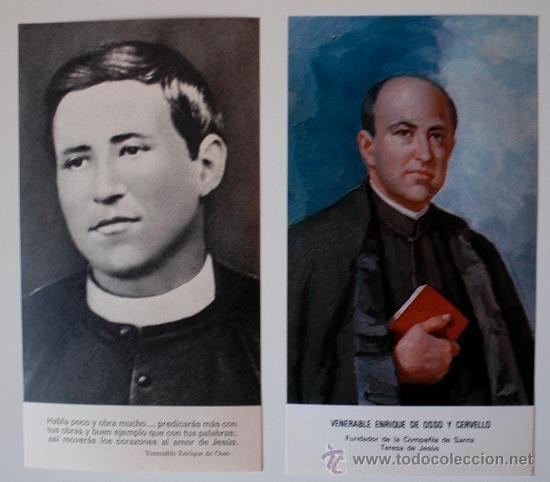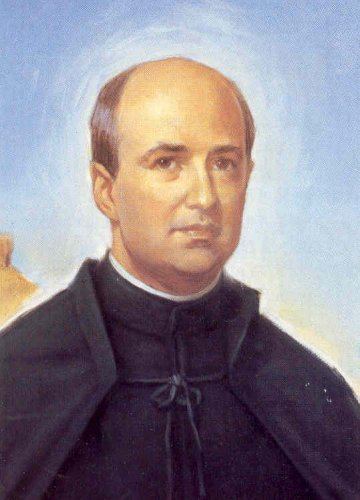Name Enrique Osso | Role Priest | |
 | ||
Parents Jaume d\'Osso i Catala, Miquela Cervello i Jove | ||
Saint Enrique de Ossó i Cervelló (16 October 1840 - 27 January 1896) was a Spanish Roman Catholic priest and the founder of the Society of Saint Teresa of Jesus. He served the role of a parish priest as an educator and an able catechist and published several works on catechesis to that effect while also expressing a keen interest in the value of women and in Saint Teresa of Ávila to whom he dedicated his congregation to.
Contents

The beatification process for the late priest commenced in 1965 - he was titled as a Servant of God from that point on - and he was later named to be Venerable under Pope Paul VI in mid-1976. Pope John Paul II beatified the late priest on 14 October 1979 and later canonized him as a saint on 16 June 1993 while visiting Madrid.

Life

Enrique de Ossó i Cervelló was born on 16 October 1840 as the last of three children born to Jamie de Ossó and Micaela Cervelló. His brother was Jamie. His brother Jamie's son was Lluís de Ossó who helped found FC Barcelona and was one of its first players.

His father had been opposed to his being a priest (while his mother favored it) and in 1852 therefore sent him to become an apprentice in the textile business in Quinto de Ebro; despite this setback he learnt the trade from his uncle who took care of him. But it was there that he became ill to the point where his First Communion was received as the Viaticum though he managed to recover and returned home while stopping off at a Marian shrine along the route to give thanks for his health's restoration.
Some time after the death of his mother in 1854 during a cholera outbreak he fled to Montserrat in order to realize his dream and attempted to seek refuge there though his brother Jamie took him home. It was when he returned that his father understood his son's desire and so relented to his son's wishes and agreed to his becoming a priest and so began his studies for the priesthood in 1854. He studied in Barcelona where he was made a sub-deacon and later studied at Tortosa before he was ordained to the priesthood on 21 September 1867; he had been a classmate of Blessed Emmanuel Domingo i Sol. The new priest celebrated his first Mass in Montserrat on 6 October 1867 and began to teach mathematics to seminarians in Tortosa.
In 1873 he founded the Association of Young Catholic Daughters of Mary and Saint Teresa of Jesus (which Pope Pius IX elevated as a confraternity in 1875) and in 1876 founded the Josephine Sisterhood. He became active as a catechist and to that effect wrote various works including one for children. He was often seen as a brilliant catechist and this seeped into his spiritual reflections; he founded and wrote for the publications known as "The Man" and "The Friend of the People" in addition to "The Teresian Review" (1872; its director until his death) while he made a point of aiming most of his writings towards women. He had a particular interest in the value of women and in Saint Teresa of Ávila. He founded the Society of Saint Teresa of Jesus in Tarragona on 23 June 1876 in order to educate women as well as the mass-movement Hermanadad Teresiana Universal. It received the decree of praise from Pope Leo XIII on 22 September 1888 and approval from the Spanish government on 1 May 1883. He hailed the release of the latter pope's encyclical "Rerum Novarum" in mid-1881 for its emphasis of Catholic social teachings.
The priest died of a sudden stroke while working with his friend Blessed Father Sol to develop a Josephine order for men on 27 January 1896 at the Franciscan convent of the Holy Spirit. His remains were later - in July 1908 - relocated into the chapel of his order at Tortona. His order now exists in places such as France and Costa Rica and as of 2005 had 1620 religious in a total of 220 houses. Full papal approval of the order came from Pope Pius X on 18 December 1903 while the pope's predecessor approved the order's constitutions and Pope Paul VI reconfirmed a new one after it was amended due to the Second Vatican Council.
Sainthood
The beatification process opened in both Tortosa and in Barcelona in an informative process that opened in 1925 and later concluded in 1927 before an apostolic process was held from 1966 until its closure in 1968. The formal introduction to the cause came on 15 July 1965 under Pope Paul VI in which the late priest was titled as a Servant of God. The newly-formed Congregation for the Causes of Saints validated these processes in Rome on 21 June 1969 while their consultants and officials met and approved the cause on 2 December 1975 before the C.C.S. on its own approved it on 27 January 1976. Paul VI approved that the priest lived a life of heroic virtue and titled him as Venerable on 15 May 1976.
The informative process for a miracle spanned from 1926 until 1927 while the apostolic process for that same miracle spanned from 1966 until 1967 while later receiving formal validation from the C.C.S. on 21 June 1969. A medical board approved it on 21 September 1977 as did the C.C.S. and their consultants on 17 October 1978 and then the C.C.S. themselves on 30 January 1979. The newly-elected Pope John Paul II approved it on 10 May 1979 and beatified him on 14 October 1979.
The second and final miracle required for full sainthood was investigated and then validated in Rome on 18 May 1990 in a move that allowed for a team of medical experts to approve it on 26 February 1992 and for a board of theologians to do so as well on 30 June 1992; the C.C.S. also did this on 1 December 1992. John Paul II approved it on 21 December 1992 and then canonized the priest on 16 June 1993 while visiting Madrid at the time. John Paul II also proclaimed him as the patron saint of catechists on 6 November 1998 in a formal decree that the Congregation for Divine Worship and the Discipline of the Sacraments issued.
The miracle that led to his beatification was that of Antonia Barrera Reig - of his order - who was healed of severe tuberculosis that damaged her stomach and intestines on 15 July 1923.
